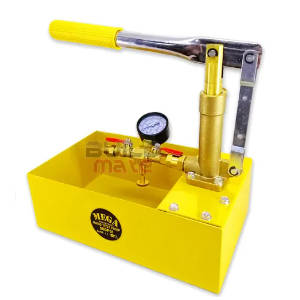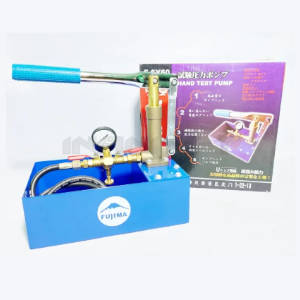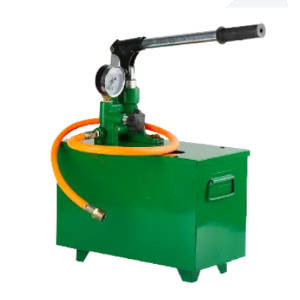Hydrostatic Test Pumps Philippines
They are also called as hydrostatic line tester to make sure that the pipes applied for moving water and other gases or fluids are secure to use. They will detect a leak no issue how little it may be. They are also used on newly installed pipes to ensure that they are secure and linked well.
Hydrostatic test pumps are also used to check repaired pipes and old systems. Using these pumps is the quickest and most perfect way to check for leakage in any pipe system. They are durable and extremely dependable.
To save the life of your pumps you need to ensure that you pick the best test pump for the work at hand. Ensure that it is installed rightly. You can use the system layout and pump applications to ensure you are using the best system and installing it rightly. Use right maintenance procedures to keep your test pump in best working situation.
Hydrostatic Test Pumps for Sale
GENERIC

- Aluminum 2.5MPa 25KG Water Pressure Tester Manual Hydraulic Test Pump Machine with G1/2″ Hose
- Material: metal
- Pressure: 2.5MPa
- Flow rate: 13ml/time
- Unit of time: seconds
- Item weight: 1.6Kg / 3.53lb
- Packaging size: 310*185*125mm
- Packaging weight: 1.7kg / 3.75lb
FUJIMA

- Fujima Portable Pressure Hand Test Pump F-SY60 (Steel Tank)
- Compact, lightweight and portable
- Pressure: 6.0MPA, 60.KG/CM2
- Flow: 13ml/ PER 500PSI
- 5MPA
- 4.5L
- 1/4″
- 35mm
TAMIRA

- Tamira Hand/Manual Hydro Test Pump 4mpa or 540Psi
- Hand Operated Hydraulic Test Pumps Manual Pipeline Pressure Test Pump
- Compact And Super Lightweight Structure Makes It Handy And Portable.
- Brand : Tamira
- Max. Pressure : 4mpa or 540psi
- Flow Volume : 22 to 32ml
- Body Material : Metal

MEGA

- MEGA Hydraulic Pressure Hand Test Pump 500PSI MHTP500
- Max. :6A
- Pressure: 60kg/cm
- Stroke: 35mm
- Rate of water suction: 13cc
- Capacity of water tank: 5kg
- Dimensions: 310x310x190mm
- Accessories: 1 Pressure Hose
- Brushing: 1/2 x 1/4 Meno: Steel Tank
Types of Hydrostatic Test Pumps
These pumps are usually installed on frames which are steady and built to last. They are prepared from aluminum aircraft or powder coated structure that is trivial and make it simple to grip. Aircraft kind of aluminum is not just strong but it is also resistant to rust and chemicals. Other specs contain a shut off value and garden hose.
Many of these pumps are designed with a damper diaphragm that stops bypass and busting value that relieves force during the start-up process. They are even made to be run dry if important.
Electric
Electric hydro test pumps are furnished with a strong but quiet 110V, single phase 50/60 Hz motor. These durable, long-lasting pumps have stainless steel pistons and brass cylinders to make sure the life of the instruments. These pumps are accessible without or with cage for further protection.
A drill-powered hydrostatic test pump is run with a 1/2 inch electric or 18V cordless drill and weight less than nine pounds, making it simple and perfect to maneuver around any work. It is a lightweight choice since the power comes from a separate drill, and there is no need to be near an outlet to find an extension cord. For uncommon jobs, consider the manual test pump HTP300 with 300 psi ability or HPT1000 with 1000 psi capacity. These hydrostatic pump weigh less than nine pounds making them portable and lightweight.
Whether it is a big construction work or modest home irrigation problem, ensure to have a hydrostatic test pump to make sure the competence of your water system.
Manual
Hydrostatic examination contains filling a system or vessel with a liquid, generally water, or pressuring until the needed test force is got. Normally, once the test force is reached, the test is done. For other tests, hydrostatic force must be held for a specific length of time. Hydrostatic testing can be used to identify structural integrity, identify system leaks, corrosion or highest burst force, manufacturing flaws. It can be used during routine safety check up, to confirm system modifications, or validate repairs have been made rightly.
Manual hydrostatic test pumps are perfect for testing residential water lines, refrigeration or heating systems, force testing little tanks, boiler, sprinkler and solar systems. They are simple to use and lightweight. Equipped with gauge, off value, and adjustable internal relief value and ten foot output hose is added.
A hydrostatic line test is a general way in which a force vessel, BOP, valve, or pipeline is checked for flaws or leaks. Testing is very important avoid failure. Little pressure vessels are generally testing applying a water jacket examination, whereby the vessel is evaluated for faults and located in a water packed container. The change in volume can be detected by checking water level. The vessel is then depressurized and pressurized so that water level in the jacket can be reexamined.
How to Use a Hydrostatic Test Pump
- Turn off your water supply.
- Cut off your pump from the system you are testing.
- Leave the pipe linked to the pump and install a ball control device to the end of pipe that was linked to the structure. Leave the control device unlock for now.
- Start your water supply, and wait for the liquid to flow out of the ball control device. If you do not have water coming out of the hose at this point there is an issue with the water supply, such as an barrier in the supply line or blocked inlet filter. Once you have water flowing via the pump and out of the control device, turn the pump on.
- As you watch the gauge, start to gradually limit the flow by gradually closing the value. The gauge should begin to show force building. Never exceed the force that the pump is designed to pump. Damage may outcome to the motor, pump, or houses.
Hydro test pumps contain of 2 main parts: the pump and whatever is being used to run the power. There are basically 3 ways to power a pump, an electric motor, a gas engine, or by hand. Motor size, (HP) will be determined by the amount of force (PSI or pounds per square inch) and volume (gallons per minute or GPM) that is needed. Even though force is vital, is reality the (GPM) will decide how long it will take to get the work done. Since the majority of tests are performed at two-hundred psi or less, having a superior GPM will save money and time. A device that is paced for 2.0 GPM @ max force of five-hundred PSI will take additional time to perform the work of a pump paced for 4.5 GPM & max force of four-hundred PSI.
If you believe that testing is taking very high time and not sure that the pump you are using is operating right, you need to be capable to diagnose the issue in the field rather than taking in for repair, just to find out that there truly is nothing bad with the pump. One query to ask is, “am I filling the system using the pump?” Keep in mind the test cannot performed until the system is full of water. if so, then the system ability will determine the test time. Your pump will just run the GPM it is paced for and no higher. So separate the system ability by the GPM pump flow to obtain some time it will take first load the structure.
If the pump is producing force using this technique then it is working the way it is made and the issue is elsewhere. General issues to look for are air in the structure, leaks or the capacity of the structure is so big.
What to Look For in a Hydrostatic Line Tester
The hydro static test pump can be used for testing old systems and repaired pipes as well. Please ensure that you are picking the best type of pump for testing to make sure that your pump works for a longer period of time. Therefore, ensure that you are exercising due discretion while picking the supplier of the hydro test pump.
If you are looking at the engine operated hydraulic test pumps, you must be on the lookout for the following specs:
- Fully confined drive mechanism
- Spacious air chamber
- A precision gear box with top sustainability
- Relief value with self oiling system
Do not forget to check the working range of the pump that you have settled for. Please make sure that you fully researching on the applications of the pump offered by the supplier – meaning which appliances (casting parts, pipes, boilers, viz) they will be capable to test.
Generally, customer should pick ten to twenty percent more force than needed. Several times, customer believe that higher pressure pump may be needed for future application. Based on that, they propose quite top force also. In such circumstances, there are many models, where price may be also same for different force and pick perfect model, only mother and other miscellaneous accessories will be changed and total cost impact may be too little e.g. if you pick T2-15-10 model for 2 1pm/ 125 kg/ cm2/ 1 hp or if you pick 1.6 lpm/ 380/ cm2 / 2hp, there possibly hardly ten to fifteen percent difference between 130 kg/cm2 and 375 kg/cm2 as the device model is equal.
Time
It is extremely vital to notify the time accessible to get wanted force. If extra time is accessible, then low flow, little pump can be picked, which will be an affordable solution.
Frequency of tests
To pick the duty of the pump, one should notify that how many hydro test is to be carried out? With this detail one can plan the right model.
Driver
Customers would love to couple automatic motor, PTO or engine is a vital to decide before selecting a model.
Hydrostatic test pumps are designed to test solar system, water meters, water lines, and sprinkle systems in commercial structures and local homes. These pumps are portable, making it perfect to use quickly on little job or move efficiently around a big plumbing system installation. Maintaining safety standards of force or waterline needs hydrostatic testing when pipes are first installed and to monitor the performance of the system over time.




